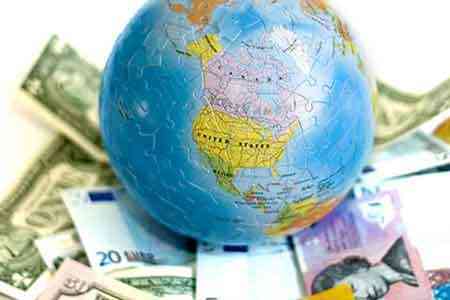


ArmInfo. In January-April 2025, the net inflow of private transfers to Armenia decreased by 16.5% per annum (against a decline of 54.5% a year ago), amounting to $273.4 million. In particular, the inflow increased by 6% to $1.8 billion, and the outflow - by 11.4% to $1.5 billion. This is evidenced by the data of the Central Bank of the Republic of Armenia.
Moreover, the dynamics of the inflow and outflow of non-commercial transfers are in different directions. The 7.3% growth in inflow (to $329.4 million) was accompanied by a 9.8% decline in outflow (to $136.9 million), which increased the net inflow by 24% to $192.4 million. The leading directions of inflow and outflow of non-commercial transfers are Russia and the United States: with the annual dynamics of both indicators for Russia moving from decline to growth (especially noticeable for inflow - from -54.5% to +17.3%), and a deterioration in the dynamics of these indicators for the United States from growth to decline (especially noticeable for outflow - from +46.1% to -43.2%).
According to the source, the largest volume of transfers comes to Armenia from Russia ($1.2 billion), and flows out to Switzerland, the UAE, the United States and Spain (a total of about $800 million).
Thus, the leading inflow of transfers from Russia amounted to $1.2 billion in January-April (annual growth of 4.3%), in second place was the United States - $210.3 million (annual decline of 1.8%), in third place was Great Britain - $48.1 million (annual growth of 80.4%), in fourth place was Switzerland - $45.4 million (annual growth of 83.6%) and in fifth place was the UAE - $31.2 million (annual growth of 6%).
The leading direction of the outflow of transfers from Armenia is Switzerland - $289.6 million (annual growth of 3.1 times), in second place is the UAE - $237.7 million (annual growth of 2.3%), in third place is Russia - $215.1 million (annual growth of 10.8%), in fourth place is the USA - $210.4 million (annual growth of 8.9%), and in fifth place is Spain - $58.5 million (annual growth of 43.2%).
Russia's share has slightly decreased over the year both in the inflow from 66% to 65% (versus 76% in January-April 2023), while remaining in the outflow at the level of 14.4% (versus 14% in January-April 2023). The UAE's share in the inflow is still tiny - 1.8%, while in the outflow it decreased from 17.3% to 15.9%. The US share decreased both in the inflow from 12.8% to 11.9%, and in the outflow from 14.4% to 14%. Switzerland's share in the inflow did not increase much - from 1.5% to 2.6%, but in the outflow it jumped from 7% to 19.3%. The UK's share increased both in the inflow - from 1.6% to 2.7%, and in the outflow - from 3% to 3.3% (versus 17% in January-April 2023). Spain's share in the outflow increased over two years from 2.6% to 3.9%, while in the inflow it remained at a tiny level of 0.5%.
According to experts, as soon as Russia and the UAE agreed to directly "carry out" trade deals with diamonds and gold (without re-export and re-import), transfers to Armenia gradually began to return to their natural dynamics (with the exception of "gray deals" with precious metals and stones). Diamonds and gold imported mainly from Russia (77% and 99.7%, respectively) were exported mainly to the UAE (77% diamonds and 64% gold) - according to customs data for the first half of 2024. Almost the same picture emerged at the end of 2023, when 46.7% of diamonds and 99.2% of gold came from Russia, which were also mainly exported to the UAE (84.6% diamonds and 71.4% gold). Since 2025, it has become impossible to conduct such transactions in the same impressive volume due to the settlement of the issue of customs duties on jewelry within the EAEU. It is known that since 2020, the Russian Federation has made a proposal to the EEC more than three times to zero out the import customs value of colored precious stones and fine-cut diamonds up to 0.2 carats. But the issue has not been resolved - Armenia has blocked the zeroing of duties. Due to the import customs duty on precious stones, it was much more profitable to import finished jewelry from third countries that are not members of the EAEU than to produce it in the union. The import duty rate on finished jewelry is lower than the rates on precious stones (10-15%) for its production. However, since 2025, this "high-yield" effect has been lost. Russia has zeroed out duties on the import of jewelry from the UAE.
In 2024, the inflow of transfers to Armenia from all countries exceeded $5.8 billion (including $1.01 billion of non-commercial nature), and the outflow - $4.3 billion (including $440 million of non-commercial nature), with the former growing by 2.5% and the latter by 7.1%. As a result, the net inflow of private transfers to Armenia in 2024 decreased by 9% - to $1.5 billion. Moreover, for non-commercial transfers, the decline in net inflow was more impressive - by 35% to $573.5 million. The share of the latter in the total net inflow decreased over the year from 53% to 38%. Russia's share in the inflow decreased over the year from 69% to 66%, while remaining in the outflow at the level of 16%. The UAE's share in the inflow is negligible - it was 1.3% and became 2%, while in the outflow it increased from 14% to 20%. The US share in the inflow remained at 12%, and in the outflow it moved from 12% to 14%.